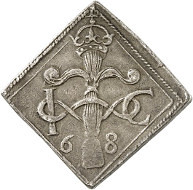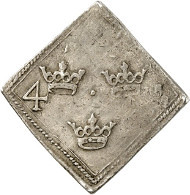
PREV ARTICLE
NEXT ARTICLE
FULL ISSUE
PREV FULL ISSUE
SWEDEN'S BLODSKLIPPINGAR OR 'BLOOD KLIPPE'
This article from CoinsWeekly discusses the fascinating story behind Sweden's 'blood klippe'. -Editor


Blodsklippingar or blood klippe is the Swedish numismatic term for coins that tell the story of one of the darkest periods of Swedish history: the drama of fraternal feud and a revolt, of great love and courageous women, of insanity, passion and lust for power – simply put, topics, numismatics is normally about. For starters, let us take a look at how the distrust between the Swedish King Erik XIV and Nils Sture came about. The Sture family was one of the most influential families in Sweden. Numerous members of the family had been appointed imperial governor, the very same position in which Nils Sture served the King. During his appointment Nils visited many courts throughout Europe to represent Sweden’s interests. But suddenly, the King tortured this cosmopolitan diplomat and sentenced him to death – because his astrologer predicted, that a man with blond hair would succeed him. Eventually, though, Erik came to realize, that through his horrific actions he had alienated the aristocracy. He pardoned Nils, but not without making him suffer more. Seated on a wretched hack, Nils had to ride through the streets of Stockholm wearing a straw wreath on his head and thereafter, he was required to leave Sweden. Nils’ supporters and friends gathered at the near-by Sture Castle to demonstrate solidarity. Now, of course the attendees probably didn’t have many nice things to say about the King, but was it really at this farewell party, that a revolt was planned? The King thought so and had one of the pages tortured. As expected, the boy confessed to everything. Thereupon, all the guests, which were present at the party, received a royal invitation to Svartsjö Castle. The ones who actually showed up were arrested and convicted for participating in a conspiracy and after sentencing were brought to Uppsala for incarceration. By this time, King Erik suffered from serious mental illness. He visited the dungeons in Uppsala twice to first beg Nils Svante Sture, for his forgiveness and then a second time to stab him. It is said, that after the murder, the King ordered the guards to kill everyone else connected to the alleged conspiracy – except for ‘Mr Sten.’ There were two men in the dungeons who bore this first name and they were the only ones to survive. A few days later, King Erik was found wandering the woods, apparently confused and disoriented. He was brought back to Stockholm and his mistress Karin Mansdotter was the only person who dared to approach him. Only one person, Katharina Stenbock, who was virtually related to every victim, demanded an audience with the King concerning the killings in Uppsala and her request was granted. Upon her arrival Erik threw himself to her feet, begged for her forgiveness and ordered his lawyer to strike an agreement. Not only did the widows and orphans of the victims receive a royal confirmation of what had happened and that their loved ones were innocent, but they also received a generous financial compensation. Märta Leijonhufvud, the widow of Svantje Sture, donated her share of the blood money. It would fund the noblemen’s revolt against King Erik that soon did break out, which means that Erik’s atonement payment actually supported his own downfall. The revolt was led by Erik’s two brothers, John and Charles. To save time, the rebels did not strike the usual round-shaped coins. Instead they produced roughly cut quadrangular plates. These klippe coins were also issued in different denominations, such as ½, 1, 2, 4, and 8 marks. The common term for this money, because of its purpose, soon became blood klippe or blodsklippingar. Mickel Hansson, who worked at the Vadstena mint that accompanied the army, designed the coins. The obverse depicts a crowned sheaf, which presents the heraldic symbol of the royal house of Vasa. It is entwined by a ribbon, which likewise weaves around the rebel’s initials - I for John and C for Charles. The reverse shows the Swedish coat of arms with the three crowns. As part of a special Sweden collection, one of these blood klippe will be offered for sale at the upcoming Künker Auction 266 on September 28, 2015. The specimen is estimated at 1,500 euros, once again proving that it is not always the coin with the highest estimate that tells the most thrilling story.
Interesting tale - truth is indeed stranger than fiction. The illustrated coin is for sale at the upcoming Künker Auction 266 on
September 28, 2015. -Editor
To read the complete article, see:
Wayne Homren, Editor The Numismatic Bibliomania Society is a non-profit organization promoting numismatic literature. See our web site at coinbooks.org. To submit items for publication in The E-Sylum, write to the Editor at this address: whomren@gmail.com To subscribe go to: https://my.binhost.com/lists/listinfo/esylum All Rights Reserved. NBS Home Page Contact the NBS webmaster 
|